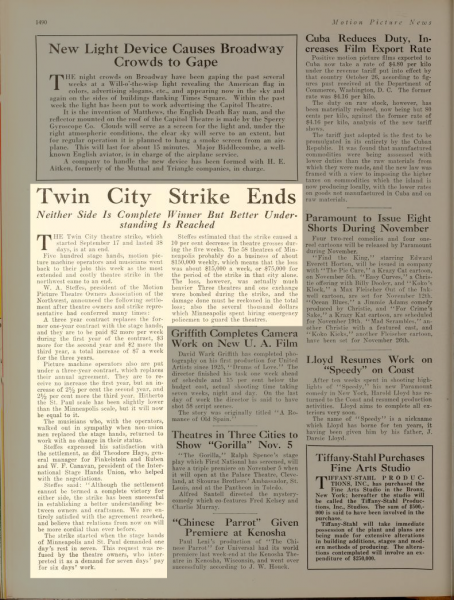| Artifact Type | Mainstream Media, Sources |
| Publication | Motion Picture News |
| Volume | XXXVI |
| Number | 19 |
| Page Number | 1490 |
| Place | New York, NY |
| Publication Date | November 11, 1927 |
| Transcript | Show/Hide |
|
Headline: “Twin City Strike Ends” Subhead: Neither Side Is Complete Winner But Better Understanding Is Reached The Twin City theatre strike, which started September 17 and lasted 38 days, is at an end. Five hundred stage hands, motion picture machine operators and musicians went back to their jobs this week as the most extended and costly theatre strike in the northwest came to an end. W. A. Steffes, president of the Motion Picture Theatre Owners Association of the Northwest, announced the following settlement after theatre owners and strike representative had conferred many times: A three year contract replaces the former one-year contract with the stage hands, and they are to be paid $2 more per week during the first year of the contract, $3 more for the second year and $2 more the third year, a total increase of $7 a week for the three years. Picture machine operators also are put under a three-year contract, which replaces their annual agreement. They are to receive no increase the first year, but an increase of 2½ per cent the second year, and 2½ per cent more the third year. Hitherto the St. Paul scale has been slightly lower than the Minneapolis scale, but it will now be equal to it. The musicians who, with the operators walked out in sympathy when non-union men replaced the stage hands, returned to work with no change in their status. Steffes expressed his satisfaction with the settlement, as did Theodore Hays, general manager for Finkelstein and Ruben and W. F. Canavan, president of the International Stage Hands Union, who helped with the negotiations. Steffes said: “Although the settlement cannot be termed a complete victory for either side, the strike has been successful in establishing a better understanding between owners and craftsmen. We are entirely satisfied with the agreement reached, and believe that relations from now on will be more cordial than ever before. The strike started when the stage hands of Minneapolis and St. Paul demanded one day’s rest in seven. This request was refused by the theater owners, who interpreted it as a demand for seven days’ pay for six days’ work. Steffes estimated that the strike caused a 10 per cent decrease in theatre grosses during the five weeks. The 58 theatres of Minneapolis probably do a business of about $150,000 weekly, which means that the loss was about $15,000 a week, or $75,000 for the period of the strike in that city alone. The loss, however, was actually much heavier Three theaters and one exchange were bombed during the strike, and the damage done must be reckoned in the total loss; also several thousand dollars which Minneapolis spent hiring emergency policemen to guard the theatres. |
|
| Archive | The Internet Archive |
| Read In Context | https://archive.org/stream/motionp36moti#page/n471/mode/2up |
| Citation | “Twin City Strike Ends,” Motion Picture News, November 11, 1927. |
| Location | MinneapolisMinnesotaSaint Paul |
| Tags | |
